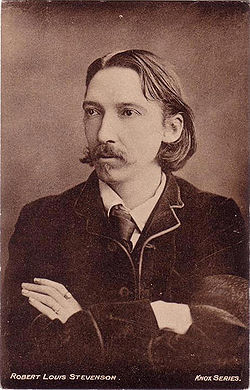Robert Louis Stevenson

Robert Louis Balfour Stevenson (13 November 1850 – 3 December 1894) was a Scottish novelist, poet, essayist and travel writer. Stevenson has been greatly admired by many authors, including Jorge Luis Borges, Ernest Hemingway, Rudyard Kipling, Marcel Schwob, Vladimir Nabokov, J. M. Barrie, and G. K. Chesterton, who said of him that he "seemed to pick the right word up on the point of his pen, like a man playing spillikins".
In late 1873, on a visit to a cousin in England, Stevenson made two new friendships that were to be of great importance to him, Sidney Colvin and Fanny (Frances Jane) Sitwell. Sitwell was a woman of thirty four, with a young son, separated from her husband. She attracted the devotion of many who met her, including Colvin, who eventually married her in 1901. Stevenson was another of those drawn to her, and over several years they kept up a heated correspondence, in which Stevenson wavered between the role of a suitor and a son (he came to address her as "Madonna"). Colvin became Stevenson's literary adviser, and after his death was the first editor of his letters. Soon after their first meeting he had placed Stevenson's first paid contribution, an essay, "Roads", in The Portfolio. Stevenson was soon active in London literary life, becoming acquainted with many of the writers of the time, including Andrew Lang, Edmund Gosse, and Leslie Stephen, the editor of the Cornhill Magazine, who took an interest in Stevenson's work. Stephen in turn would introduce him to a more important friend: visiting Edinburgh in 1875, he took Stevenson with him to visit a patient at the Edinburgh Infirmary, William Henley. Henley, an energetic and talkative man with a wooden leg, became a close friend and occasional literary collaborator for many years, until in 1888 a quarrel broke up the friendship. He is often seen as providing a partial model for the character of Long John Silver in Treasure Island.
In November 1873, Stevenson had a physical collapse and was sent for his health to Menton on the French Riviera. He returned in better health in April 1874, and settled down to his studies, but he would often return to France in the coming years. He made long and frequent trips to the neighbourhood of the Forest of Fontainebleau, staying at Barbizon, Grez-sur-Loing and Nemours, becoming a member of the artists' colonies there, as well as to Paris to visit galleries and the theatres. He did qualify for the Scottish bar in July 1875; and his father added a brass plate with "R. L. Stevenson, Advocate" to the Heriot Row house. But although his law studies would influence his books, he never practised law. All his energies were now in travel and writing. One of his journeys, a canoe voyage in Belgium and France with Sir Walter Simpson, a friend from the Speculative Society and frequent travel companion, was the basis of his first real book, An Inland Voyage (1878).
